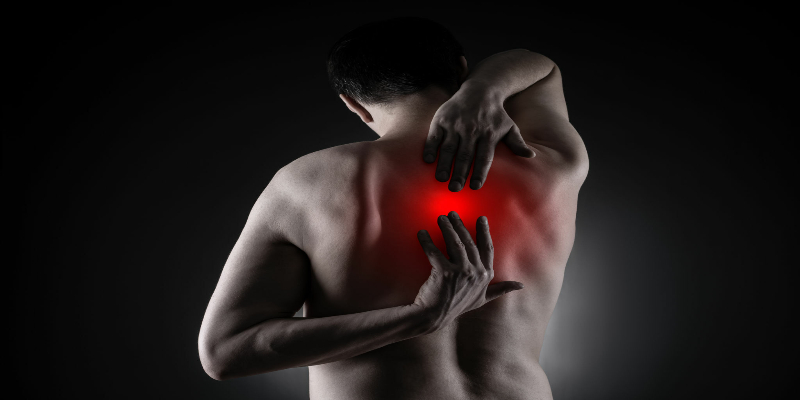Upper back pain is the second most prevalent musculoskeletal pain. It can occur anywhere from the skull’s base to the rib cage’s bottom. There are various risk factors associated with this pain, including prolonged sitting, repetitive activities, stress, psychological issues, bad posture, etc.
You may often get pain in your upper back due to local injury or trauma. Though its symptoms vary in people from mild, moderate, or severe discomfort, it may feel like a discomforting pain. If you ever experience pain or discomfort in your upper back but don’t know how to cope, we’ve got you covered.
But before going into the various upper back pain causes and treatments, let’s set the stage by defining what upper back pain is.
What Is Upper Back Pain?
Upper back pain refers to the pain in the thoracic spine region. The thoracic spine includes your upper and middle back and has 12 vertebrae. Each vertebra in your upper back combines with a vertebral disk. The disk acts as a shock absorber during movement.
Moreover, some muscles and ligaments also hold your spine and upper back together. Pain in your upper back has multiple causes: disc herniation, neck strain, and local injury. You may experience it from the base of the neck to the upper thoracic region.
Because the bones in your upper back area don’t move, you might often feel pain in this region. However, it could be extremely unpleasant and painful.
Upper Back Pain Types
There are primarily two types of upper back pain.
Thoracic Pain
Your thorax consists of 12 vertebrae to which the ribs attach. In comparison to lower back pain, pain in your upper back occurs due to underlying conditions. Ask for help from your doctor if you experience any of the following symptoms along with the pain in your upper back.
- Fever and chills
- Weight loss
- Numbness and tingling in legs and back
- Joint stiffness and swelling
- Onset of pain before 20 and after 50
Middle Back Pain
Although upper and middle back pain is considered the same, the middle back pain occurs above the lumbar region but below the rib cage. The diagnosis of middle back pain is challenging due to vague symptoms. However, there are various reasons for middle back pain, including pregnancy, stress, overweight, smoking, etc.
Causes of Upper Back Pain
There are several causes of upper back pain, and some of the common ones are described below.
Poor Posture
It weakens the muscles in your back due to deconditioning. If you are used to sitting in a slouched posture, your muscles become weak and prone to strain. Your poor posture also increases the thoracic spine’s curve, leading to pain.
Overuse of Muscles
It is another common reason for pain in the upper back. You may overuse your muscles by:
- Throwing or catching balls in sports activities.
- Lifting heavy objects.
- Doing house chores
- Repetitive typing and twisting
- Prolonged use of mobile phone with bad posture
If you are involved in any of these activities, you may experience pain in your upper back due to muscle strain, spasms, weakness, and nerve entrapment.
Disc Herniation
As already mentioned, each vertebra consists of the vertebral disk. Each vertebral disk comprises an outer fibrous covering annulus and an inner jelly-like structure, nucleus pulposus. When the annulus fibrous is damaged due to stress or trauma, the nucleus pulposus is displaced from its actual place, leading to a herniated disc.
The herniated disc may compress your spinal nerves, leading to severe pain. Although it is common in the lower back, it may occur in your thoracic and neck region, mainly affecting your cervical spine.
Trauma
A trauma or local injury is the main cause of upper back pain. It can be due to motor vehicle accidents, falling, slipping, and lifting large weights. Sometimes, the pain due to trauma diminishes after a short period of the incident, while in some cases, it may prolong up to 6 months to years. Traumatic injuries can be fatal, leading to vertebral fractures, nerve damage, and paralysis.
Osteoarthritis
It is a degenerative joint disease that breaks down your joint tissues. It is the most common type of arthritis, primarily affecting your knee joint in older age. But it can also make your upper back hurt, feel stiff, and swell up.
This problem can wear away the cushioning in your bones, so they start rubbing together in your upper back. It happens slowly over time, so at first, you might only feel a little pain.
Scoliosis
Scoliosis is an abnormal C-shaped curvature of the spine. This abnormal curvature can compress your spinal nerves and may alter the shape of your spinal disc. All these changes lead to pain in your upper back. Almost 3% of US adults suffer from scoliosis due to unknown reasons.
Spinal Infection
Spinal infection is a rare cause of upper back pain. It occurs due to the accumulation of pus and germs between the bone of your spine and the spinal cord. It can lead to severe pain and swelling if your diagnosis is delayed.
Myofascial Pain Syndrome and Fibromyalgia
Myofascial pain syndrome is a musculoskeletal pain that occurs due to the formation of trigger points in your fascia and muscles. Trigger points are the muscle knots that may form throughout the body due to overuse, leading to localized and radiating pain.
Fibromyalgia is a chronic condition that occurs due to the formation of tender points throughout the body. Tender points are the pain points that cause pain upon touch. It may also lead to fatigue and sleep disruption.
Other Medical Conditions
Upper back pain may occur due to other medical conditions, including respiratory issues, lung & breast cancer, gall bladder stones, and certain liver and heart problems. So, you should consult your doctor for the pain in your upper back to rule out the condition.
Symptoms of Upper Back Pain
You may experience pain in your upper back as localized, throbbing, aching, shooting, radiating, and dull pain, depending on the cause. The severity of back pain varies from person to person. Depending on the type, intensity, and location, you may have the following symptoms of upper back pain.
- Morning stiffness and reduction in pain with activity
- Aggravating pain with walking and bending
- Severe pain while sitting, resting, and lying
- Radiating pain in legs and feet
- Numbness and tingling in the specific area and legs
Your back pain could be threatening if you experience the following symptoms.
- Severe pain that doesn’t relieve with medications
- Numbness and tingling
- Fever and chills
- Pain due to a fall
- Sudden weight loss
- Sleep disruption
- History of osteoprosis
Diagnosis of Upper Back Pain
Your doctor can perform various tests to diagnose your back pain. The type of examination depends on the type, location, and severity of pain. Below are the major steps that your doctor follows to make a diagnosis.
- Complete current, past, and family medical history
- Location, intensity, duration, time, aggravating, and relieving factors of pain
- Physical examination of your spine and posture
- Assessment of reflexes, sensations, range of motion, and muscle strength or power
- Blood tests to rule out conditions that cause inflammation
- Magnetic resonant imaging (MRI) and computed tomography (CT) scans to get high-quality imaging of your upper spine and surrounding tissues.
- X-ray to examine the shape of your spinal vertebrae and to identify fractured bones
- Bone scans to identify the details of your spine and the bone metastasis.
- Electromyography (EMG) to identify the problems in your nerves and muscles.
Upper Back Pain Treatment
There are several ways of upper back treatment. These include certain medications, physical therapy, and surgery. Let’s discuss them in detail.
Medications
Your doctor may prescribe you the following medicines to treat your pain:
- Topical gels or creams, over-the-counter pain relievers like lidocaine
- Non-steroidal anti-inflammatory drugs, including ibuprofen and naproxen.
- Muscle relaxants to relieve chronic back pain
- Spinal injections to numb the area that causes pain in your back
- Certain pain-killers and steroids
All these medications can give you sudden relief, but don’t use them without your doctor’s advice. This is because every medicine has side effects, as NSAIDs may result in multiple organ damage.
Conservative Treatment
Conservative treatment includes physical therapy and chiropractic. These treatments include the following options.
- Physiotherapy: It includes electrotherapy, cryo & hydrotherapy to relieve back pain, back stretches to reduce stiffness, and strengthening upper back pain exercises to strengthen your back muscles. It also includes correction of posture, spinal manipulation to adjust your spine, and daily physical activities to increase endurance.
- Chiropractic: A chiropractor readjusts and realigns your spinal vertebrae by using manipulation techniques to relieve your back pain, inflammation, and stiffness and increase the range of motion. You can contact the Champion Wellness Centers of Valrico to get the best chiropractic services.
- Acupuncture: Besides upper back pain exercises, acupuncture is another treatment that uses thin needles to reduce back pain.
This conservative management works as a miracle to relieve your back pain, but you should always seek advice from an expert.
Surgery
Surgery is the last treatment option for your back pain when all the options fail, except for trauma or accident. Your surgeon can perform the following invasive treatments.
- Discectomy to treat disc herniation by removing part of the disc.
- Spinal fusion surgery to remove the disrupted part of vertebrae.
- Disc replacement surgery to remove the damaged disc.
- Laser surgery to reduce the size of the disrupted disc to relieve pressure on spinal nerves.
FAQs
How to Relieve Upper Back Pain Fast?
You can relieve the upper back discomfort by following the home remedies. For this, you can use a heating pad that increases blood circulation in the area and reduces your pain. You can also do gentle massage and back stretch to reduce pain.
When Should I Worry About Upper Back Pain?
You should be worried about your upper back pain if it doesn’t improve even after one week of treatment. If you have symptoms like fever and chills, consult your doctor immediately. Additionally, seek medical advice if you have numbness, tingling in your legs, or sleep disruption.
What Is a Natural Remedy for Upper Back Pain?
There are various natural remedies to reduce upper back pain, including turmeric milk and ginger-green tea. You can also reduce your pain by maintaining a sleep cycle of 7 hours. Moreover, maintain your posture to avoid pain.
What Deficiency Causes Upper Back Pain?
Calcium and Vitamin D deficiency is crucial in causing back pain and muscle spasms. Taking enough calcium and Vitamin D daily can lower the risk of back pain. This is true if you are suffering from osteoporosis.
Final Words
Finally, a thorough understanding of upper back pain reveals its multifaceted causes. These include traumatic events and poor posture to muscle overuse, osteoarthritis, scoliosis, and spinal issues.
The wide range of sensations, including throbbing, aching, and sharp pain, highlights the condition’s complexities, with symptoms varying depending on the underlying cause and location.
For those wrestling with severe upper back pain or persistent concerns, seeking professional guidance is critical. At Champion Wellness Centers of Valrico, we’re well-equipped to partner with you in understanding your specific upper back pain causes and treatments. We prioritize relief from the immediate discomfort and your overall well-being.
If you have any questions, please reach out to us. We would like to assist in relieving your upper back pain.



